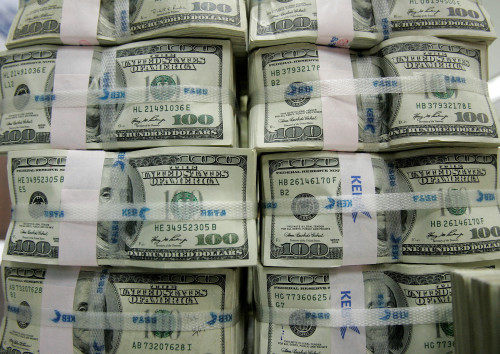By Laura Matthews and Saqib Iqbal Ahmed
NEW YORK (Reuters) -The U.S. dollar has steadied after a sharp tumble this year but traders in the foreign exchange options market are positioned for the U.S. currency to weaken further amid growing concern about the U.S. economy and persistent trade-related tensions.
Investors started the year expecting the Trump administration’s policies to boost the dollar, helped by his tax cuts and safe haven demand stemming from protectionist policies.
But that view quickly soured when U.S. President Donald Trump unveiled levies in April that were larger and broader than anticipated, spiking volatility and sending the dollar to a three-year low.
While a temporary pause in some of the reciprocal tariffs has helped calm nerves, the options market still paints a dour outlook for the dollar.
The options market can offer a view on how investors and traders expect currencies to fare months down the line.
“FX option prices in general continue to point to a greater risk of further dollar weakening,” said Tim Brooks, head of FX options at Optiver. “From our perspective there is no clear single large position, but relative to the past 5-10 years, we see unprecedented demand from investors to own USD puts in comparison with at-the-money options or USD calls.”
Put options confer the right to sell the underlying security at a fixed price and date and are typically bought to express a bearish view. Their bullish counterpart is the call option, which grants the right to buy at a set price and known time frame.
Because the foreign exchange market quotes currencies in pairs like dollars per euro, and yen per dollar, a bullish position on the euro indicates a bearish view on the dollar.
FX risk reversals, a type of options strategy that involves the simultaneous purchase of a put option and sale of a call, or vice versa, are useful indicators of which currency is seeing more demand. Pricing on several of these currency pairs remains near multi-year highs despite the pause in the dollar’s slide this year, highlighting the market’s bearish stance on the buck.
According to LSEG data, the three-month, six-month, and one-year 25-delta EURUSD at-the-money risk reversal measures just edged off their highest level of bullishness for the euro against the dollar on records dating to 2007, apart from a brief interlude during the 2020 pandemic’s market disruption.
“Positioning remains extremely bearish on the dollar,” Karl Schamotta, chief market strategist at Corpay, said.
“Pricing increases across the curve, with one-year risk reversals trading well above their shorter-term equivalents, suggest that options market participants expect the euro to continue its gradual grind higher,” he said. The euro is up nearly 10% against the dollar this year.
DOLLAR BEARS AT PLAY
Other popular bets being placed are for the dollar to fall against the yen, Sagar Sambrani, senior FX options trader at Nomura, said.
Investors are building up positions in dollar puts, trades to sell the U.S. currency particularly against currencies like the euro and sterling, suggesting they remain convinced the greenback has more losses in store.
CME Group’s options data show USD puts have drawn strong demand, both in aggregate and against most major currencies. In May, USD puts made up just over 59% of traded FX options volume, said Chris Povey, head of FX options at CME Group.
Demand for dollar puts over calls was especially apparent in the yen and the Australian dollar, Povey said, making up more than 65% of the options volume in those pairs.
Options data hint at expectations that the pace of decline in the dollar from here may be more measured relative to the sharp drop seen since the start of the year.
The dollar is down about 9% against the euro, and the yen, respectively, for the year. The euro was last at $1.1443, and the dollar was trading at 142.70 yen.
“Traders think spot market momentum will fade in the short term, but are betting on a gradual narrowing in relative growth differentials between the advanced economies by the autumn, along with a slow-motion diversification push over the next year, with major investors reallocating resources toward structurally undervalued markets outside the United States,” Corpay’s Schamotta said.
CONTRARIANS BEWARE
Investor confidence in the U.S. economy outperforming the rest of the world has taken a knock in recent months. Worries about rising U.S. debt and a widening budget deficit have also come to the fore, bolstering investors’ desire to lighten up on U.S. assets.
“I don’t think we have the conviction to fight this consensus,” Jayati Bharadwaj, a global FX strategist at TD Securities.
“The new announcements that we have seen since the start of the year … after a long time there are fundamental reasons to be bearish on the dollar,” she said.
With trade policy in flux, the dollar could well experience modest relief rallies. It also has the great advantage of being the No. 1 central bank reserve currency, backed by the world’s safest and most liquid government debt market, with higher interest rates than rival developed-economy currencies. But on balance, the path of least resistance for the dollar is lower, strategists and investors said.
“We’ve seen a significant amount of buying of dollar puts coming from a number of different types of clients,” said an FX options trader at a large U.S. bank, who did not want to be named because of the private nature of these trades.
“We still want to have exposure to dollar weakness, because that’s the trade that when you add up all the things that are going on in the world probably makes the most sense,” the trader said.
(Reporting by Laura Matthews and Saqib Iqbal Ahmed in New York; Editing by Alden Bentley and Sandra Maler)


